#kyoto daimaru
Explore tagged Tumblr posts
Text







今回はスマホ写真でレポ。
大好きな写真家、星野道夫さんの作品展が京都で開催中なので行ってきました。僕にとって、氏の写真集 ARCTIC ODYSSEY はいまだにバイブル。氏は事故で逝去されましたが、今も数年毎にこのような機会でプリントを見ることができるのはありがたいです。
写真展の後は昭和レトロなお好み焼き屋さんでランチ。オッサン一人の行動が多いのでどうしてもレトロ食堂や町中華なんかに入りがち…オサレなカフェでプレートランチ…なんてなかなか敷居が高いです😓
#京都#kyoto#大丸#kyoto daimaru#写真展#photo exhibition#星野道夫#michio hoshino#お好み焼き#okonomiyaki#焼きそば#yakisoba#japanese soul food#ミスター・ヤングメン#mr.youngmen#photographers on tumblr#natgeoyourshot
98 notes
·
View notes
Text

Part II of the Cyborg 009 60th pop up is underway, this time on the 4th floor of the Daimaru Kyoto department store! As with the previous pop up this event runs for one week and will feature a very wide collection of new merchandise, re-mint series, and also an exhibition section with original illustrations. If there was something you wanted but missed out on during the first pop up, this may be your second chance.
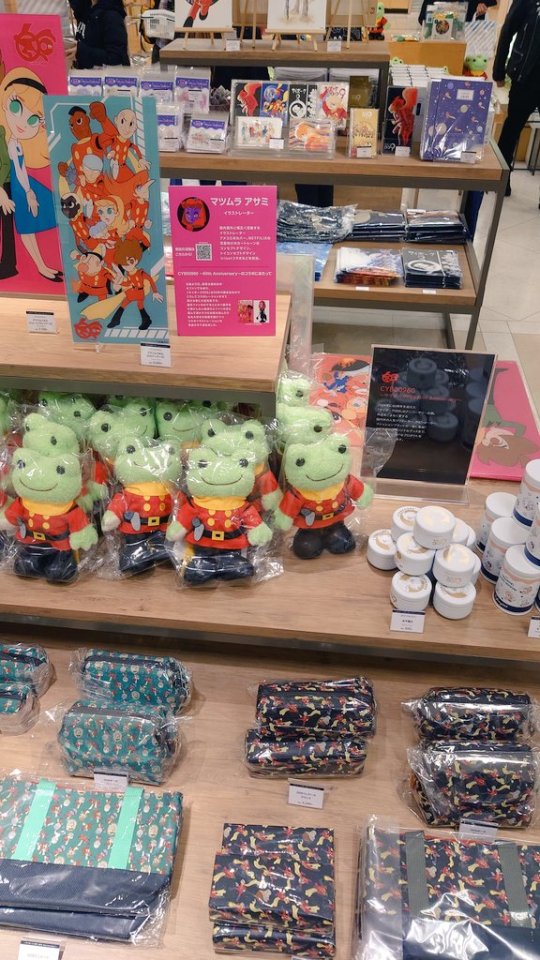



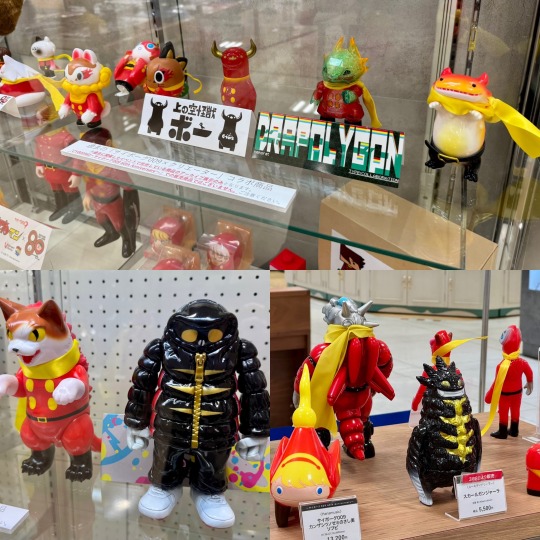

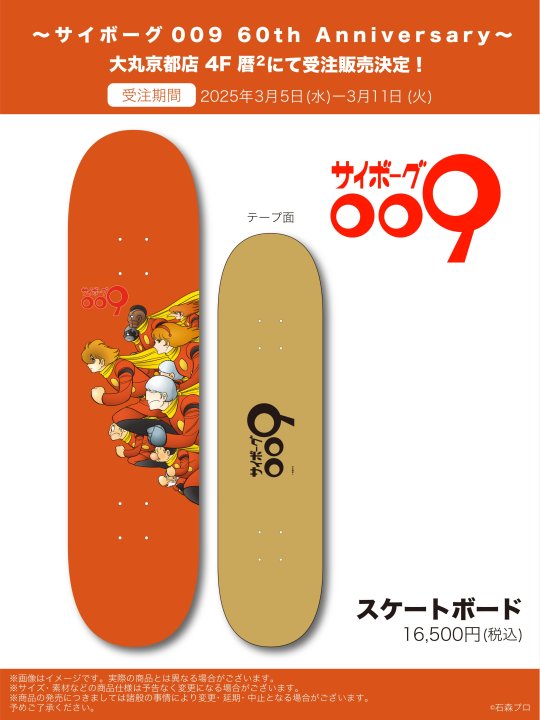
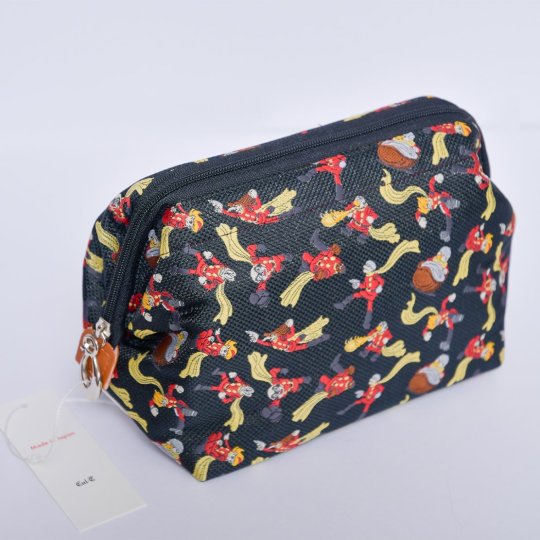



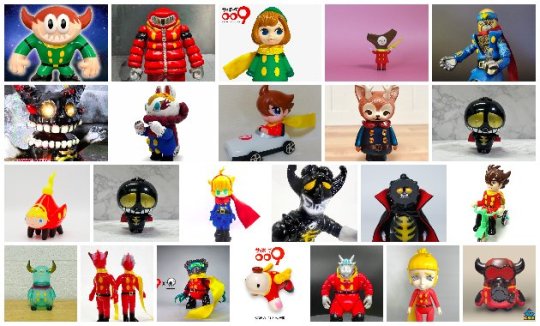
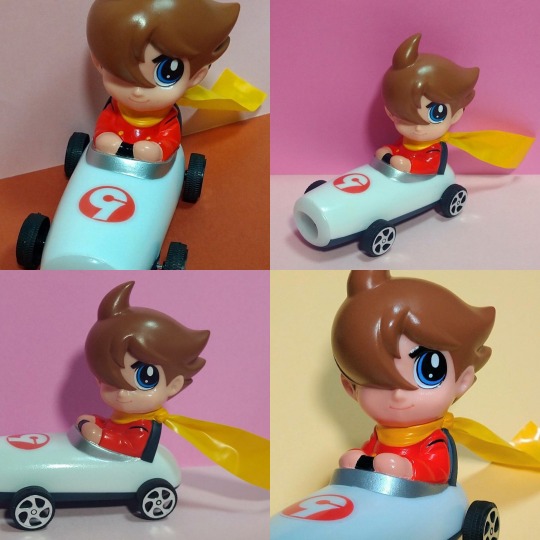



There is a good selection from recent anniversary releases including fashion goods, standees, figures, stationary, home goods, collaborations, and a heavy sofubi presence. Certain goods are available by lottery system only, and sofubi sales are limited to one variant from each artist, per guest. Though it is also noted the sofubi sales are subject to change based on available quantity. As with the previous pop up leftover goods will be made available online starting* Friday March 21st and ending Sunday April 20th here. If you are outside of Japan you will need to use a proxy service. *If you are US based please keep in mind we are a day behind so the sales period begins on the 20th for us.
source: x
#cyborg 009#c009#merch news#60th anniversary#I was shocked at how quickly the pickles the frog goods went at the last event
8 notes
·
View notes
Text

【京都個展、前日】
今日は搬入日。
今から新幹線に乗っていざゆかん京都!です。
画像は今朝まで描いていた、出来たてほやほやの新作「バッカス」。
酒飲みはご存知、ローマ神話に登場するお酒の神様です。豊穣とブドウ酒、そして酩酊と狂乱の神でもあります。豹、虎、牡山羊などを聖獣とし、葡萄や酒杯、豊穣の角などが象徴として挙げられます。
次の一杯を狙っている豹の姿はまるで自分の姿を見ているかのよう…搬入が終わった後のお疲れの一杯がいっぱいにならないように気をつけたいと思います😅🍷
———
「ミチヨ スクラッチ絵画展 〜神話伝承 古今東西〜」
7月17日(水)〜23日(火)※最終日午後5時閉場
京都大丸店 アートサロンESPACE KYOTO
【Kyoto solo exhibition, day before】
My solo exhibition opens tomorrow.
I’m looking forward to seeing you there!
This image is my new work, "Bacchus", which I had been working on until this morning.
Bacchus is the god of drinking in Roman mythology. He is the god of fertility and wine, as well as drunkenness and madness. The leopard, tiger and male goat are his sacred beasts, and his symbols include grapes, drinking cups and fertility horns.
The leopard's eyes looking for the next drink are like watching myself... I'll be careful not to fill up on a tired drink after the work😅🍷.
———
Michiyo Scratch Painting Exhibition - Mythological &Lore, Everywhen and Everywhere.
Wed 17 - Tue 23 July *Close at 5pm on the last day.
Kyoto Daimaru Art Salon ESPACE KYOTO
#ミチヨ#michiyo#展示会#artexhibition#スクラッチ画家#scratchart#スクラッチ絵画#神話#art#myth#アート#豹#バッカス#leopard#bacchus#京都#kyoto
26 notes
·
View notes
Note
Hi I saw your photos in the Japan community and I would love to get some photos of the pride stuff in Kyoto. Can you share where it is?
yes of course!! i hope they’re still up and you can catch them in time. that was along the main shopping street in kyoto so if you’re headed to nishiki/gion etc you’ll probably hit that shopping arcade. just look for hands/daimaru. daimaru has a rainbow light up after sunset for pride month so if you go at night you can get photos of that
#also i’m so sorry to anyone who sent in asks i just realised i have literally 400+ of them#there’s no way i’m ever catching up on that backlog ;___; if you sent something urgent please poke me again to have a look at it
25 notes
·
View notes
Text
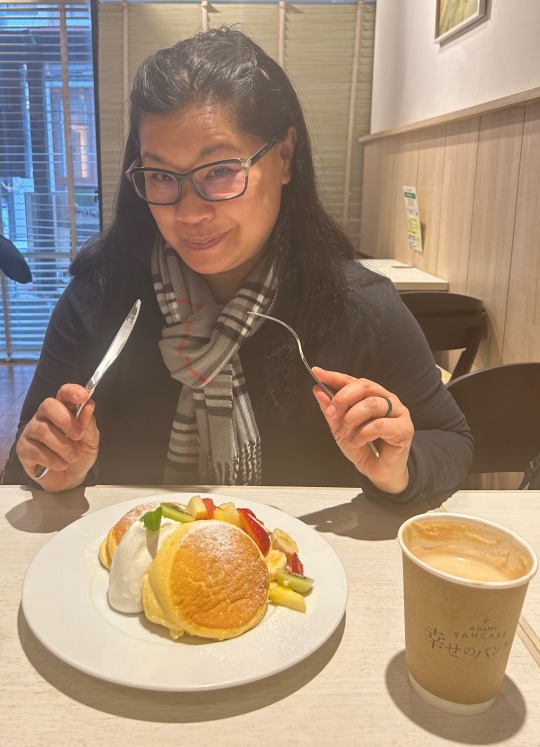
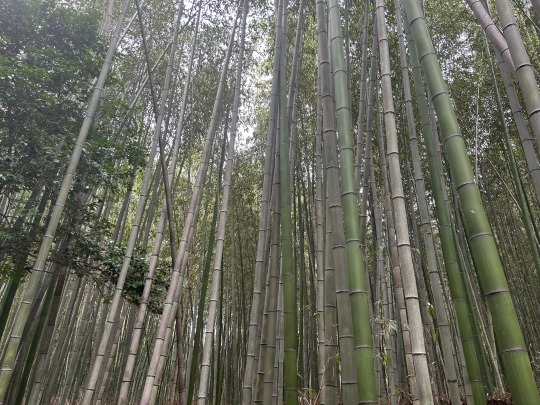
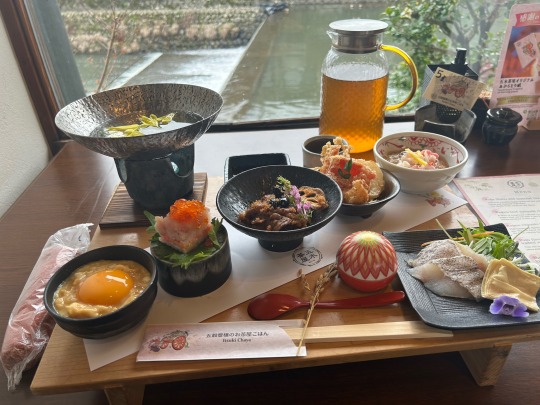
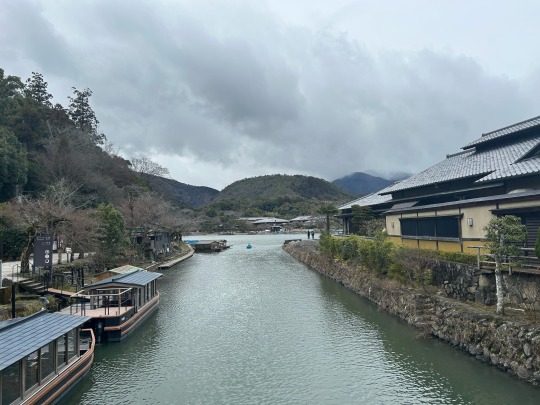
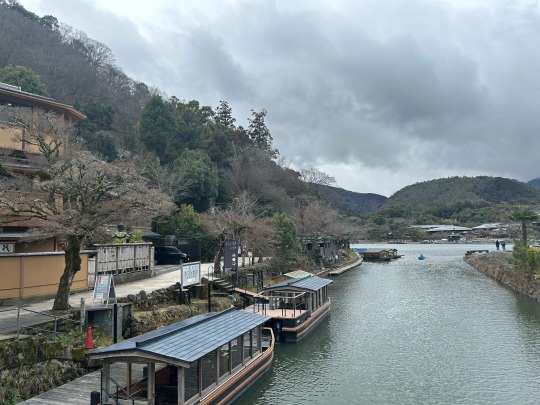
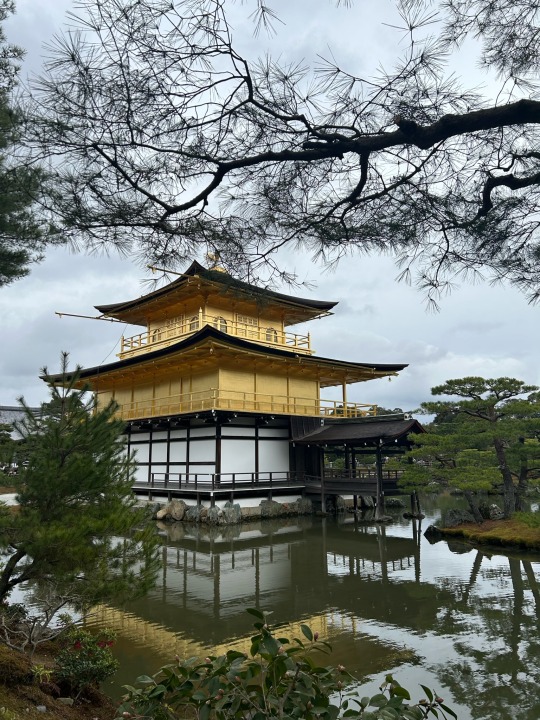
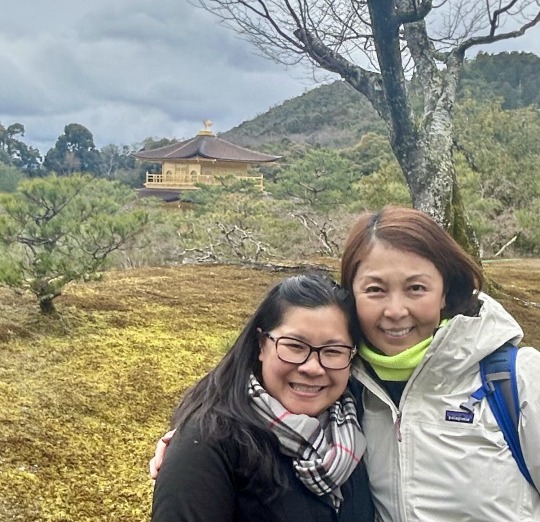

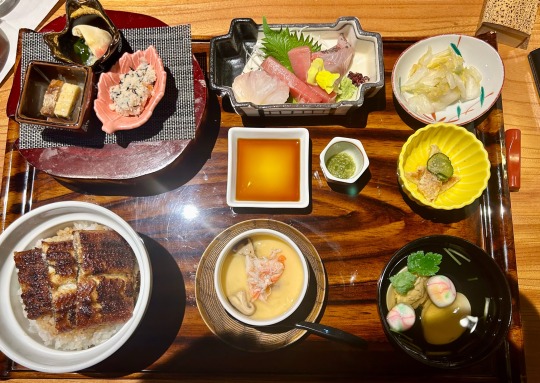
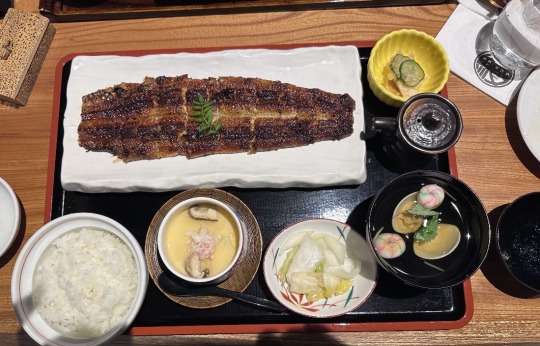
Linda is such a trooper; she’s still sick, but powering through the day and not letting it get in the way of seeing a few of Kyoto’s most famous sights. But first, fluffy pancakes.
We went to Arashiyama first to visit the bamboo forest and enjoyed a traditional Harenohi Gozen meal at Itsukichaya restaurant. Then we visited the Golden Pavillion (Kinkaku-Ji Temple), which never ceases to take my breath away. The temple is stunning, but the surrounding environment makes the whole experience extremely peaceful. It makes sense since it is, hello, a Zen Buddhist temple. Our final stop was to go, on purpose, to the food stalls of Nishiki Market. It was super crowded because it’s a National Holiday today (Happy Birthday to Emperor Naruhito) and everyone was out and about.
Dinner was at an eel restaurant on the top floor of a Daimaru department store. You can see one of the chefs killing the eels outside the main kitchen. We decided we weren’t going to find fresher eel than this, and indeed the whole meal was amazing. We visited our third department store food hall and bought some bread for breakfast tomorrow. All in all, another busy, but super fun, day.
2 notes
·
View notes
Photo
Herb Ritts
Herbert Ritts Jr. (13 de agosto de 1952 - 26 de dezembro de 2002) foi um fotógrafo e diretor de moda americano conhecido por suas fotografias de celebridades, modelos e outras figuras culturais ao longo das décadas de 1980 e 1990. Seu trabalho se concentrou em fotografia em preto e branco e retratos, geralmente no estilo da escultura grega clássica , que enfatizava a forma humana.
Início da vida e educação
Ritts nasceu em 13 de agosto de 1952, em Brentwood, Los Angeles . Seu pai, Herb Ritts Sr. (née Rittigstein), era um designer de móveis e sua mãe, Shirley Ritts (née Roos), era uma designer de interiores. Juntos, seu negócio de móveis ajudou a popularizar móveis de vime nas décadas de 1950 e 1960. Criado em uma família judia abastada , ele e seus três irmãos mais novos viviam ao lado do ator Steve McQueen , a quem ele considerava “como um segundo pai”.
Em seu bar mitzvah , seu pai o presenteou com uma câmera Kodak Brownie . Ele estudou na Palisades High School e mudou-se para o interior do estado de Nova York em 1972 para estudar no Bard College , onde se formou em economia com especialização em história da arte. Após a formatura em 1975, ele voltou para a Califórnia para trabalhar como representante de vendas na empresa da família.
“Estou feliz por não ter ido à escola para fotografia. Outros fotógrafos que conheço, Helmut Newton e Bruce Weber, também não. Até Steven Meisel não foi, na verdade — ele foi para a escola de moda. Para mim, a coisa mais importante que aprendi foi apenas aprimorar meu olhar. […] Eu estava me ensinando, eu acho. Muitas pessoas que se destacam são autodidatas”.
Ritts comprou sua primeira câmera em 1976, uma Miranda DX-3 de 35 mm.
Carreira
Mais tarde, enquanto morava em Los Angeles, ele se interessou por fotografia quando ele e o amigo Richard Gere , então um aspirante a ator, decidiram tirar algumas fotos na frente de um velho Buick. A foto rendeu a Ritts alguma cobertura e ele começou a levar a fotografia mais a sério. Ele fotografou Brooke Shields para a capa da edição de 12 de outubro de 1981 da Elle e fotografou Olivia Newton-John para seu álbum Physical em 1981. Cinco anos depois, ele replicou a pose da capa com Madonna para seu lançamento de 1986, True Blue . Naquele ano, ele fotografou Tina Turner para o álbum Break Every Rule .
Durante as décadas de 1980 e 1990, Ritts fotografou celebridades em vários locais da Califórnia. Alguns de seus temas durante esse período incluíam artistas musicais. Ele também tirou fotos de moda e nus das modelos Naomi Campbell , Stephanie Seymour , Tatjana Patitz , Christy Turlington e Cindy Crawford , incluindo “ Tatjana, Veiled Head, Tight View, Joshua Tree, 1988 ”. O trabalho de Ritts com elas inaugurou a era da supermodelo dos anos 1990 e foi consagrado por uma de suas imagens mais celebradas, “Stephanie, Cindy, Christy, Tatjana, Naomi, Hollywood, 1989”, tirada para a Rolling Stone .
Ele também trabalhou para Interview , Esquire , Mademoiselle , Glamour , GQ , Newsweek , Harper’s Bazaar , Rolling Stone , Time , Vogue , Allure , Vanity Fair , Details e Elle . Ritts tirou retratos publicitários para Batman , Batman Forever e Batman & Robin , que apareceram em capas de revistas e mercadorias ao longo da década de 1990. Ele publicou livros sobre fotografia para vários designers de moda.
De 1996 a 1997, o trabalho de Ritts foi exibido no Museu de Belas Artes de Boston, atraindo mais de 250.000 pessoas à exposição, e em 2003 uma exposição individual foi realizada no Museu Daimaru, em Kyoto , Japão.
Vida pessoal
Ritts era abertamente gay. Ele teve um relacionamento com o advogado de entretenimento Erik Hyman de 1996 até sua morte em 2002. Seus pais aceitaram e apoiaram sua sexualidade. Ritts era HIV positivo . Ele foi diagnosticado pela primeira vez em 1989 e usou tratamentos alternativos de ervas para combater sua condição. Ele nunca divulgou publicamente seu diagnóstico.
Morte
Em 26 de dezembro de 2002, Ritts morreu em Los Angeles de pneumonia aos 50 anos. De acordo com o publicitário de Ritts, “Herb era HIV positivo, mas esta pneumonia em particular não era PCP ( pneumonia pneumocística ), uma infecção oportunista comum da AIDS. Mas no final da vida, seu sistema imunológico estava comprometido.“

“MALE NUDE WITH CHAIN” HERB RITTS // 1984 [gelatin silver print | 32.7 × 26.4 cm.]
517 notes
·
View notes
Note
Spill the shopping recommendations!! For when I go to Japan 😍
i’ll give some simple kansai shopping recs for the big three cities 😌 these are all pretty big regular shopping destinations for locals, not b-sides, but i think because of that they often get overlooked when you come on vacation. if you’re interested in finding a certain type of thing or vibe, send me an ask and i’ll see if i can think of a recommendation!
kobe: Harbor Land and Meriken Park, shopping right along the harbor in an outdoor setting, tons of shops all in one place so you can get your fix on a lot of things you might be looking for on your trip. i like to go the the nearby chinatown (nankinmachi) for dinner, and if i have energy i’ll make my way to the ropeway and take in the night views of kobe from atop rokko mountain. it’s an incredible cityscape.
osaka: LUCUA 1100, in particular the 2nd floor which has a bunch of handmade accessories and small shops. i like to get brunch at bills (it’s an australian restaurant) on the 7th floor. or if there’s a wait i’ll get a box of two steamed buns from HORAI 551 from the satellite location near the station or the sit-in location at daimaru department store. or, ill find a new place to eat depending on my mood! osaka station city is super expansive and exploring the whole umekita area never gets old for me.
kyoto: INOBUN, any of their stores in kyoto but i think the one on shijo is fun and accessible. it’s often booked full but the cafe Soirée is famous for a rainbow jelly fruit punch drink that is super iconic, and Karafuneya has like 100 different parfaits to choose from (i like their french fry parfait!) and they have a store by shijo as well. walking pontocho at night for dinner is also very atmospheric.
0 notes
Text
KYOTO Shijo West - Kohchosai (bamboo items)🪑 - Weekenders Coffee☕️ - Daishodo woodblock prints🪑*** - Isoya (veggie focused izakaya) 🍗** - Bungalow (yummy izakaya) 🍗** - Bar rocking chair 🍺 - Calvador 🍺 - Ki no bi🍺 - Nishiki market / Aritsugu 🔪 - Nishiki market / Kitchen shop Kawataki🪑*** - Mumokuteki (Large homewares shop) 🪑 - Muku / teramachidori (ArchDigest reco) 🍵 - Wakabaya (ceramics) 🍵 Gion - Shinmonzen-dori (antique shopping) 👺*** - Maiko antiques 👺 - Kishin kitchen (Japanese breakfast) 🍗 - Bar Talisker 🍺 - Birdland (piano) 🍺 - Kyoto Handicraft center 🪑*** - Black cat lemonade 🍋*** - Jazz spot yamatoya (12-10p)🎵*** Philosophers path - Kanaamitsuji (metal strainers) - Kodaiji temple🪑 - Kiso artech (wood items) 🪑 - Brown eyes coffee☕️ - Suirokaku water bridge🏛️*** - Ofuda👺👺👺👺👺👺👺👺👺👺👺👺 Kyoto station - Kurasu (Coffee) ☕️** Sannenzaka - Otowa Waterfall (longevity spring water) 👺*** - Kiyomizu dera (large wooden structure) 🏯 - Arabica ☕️ - Nittodo☕️🪑*** - Unir coffee (has flan, cakes) ☕️ - Koma Gallery Coffee☕️ - 高台寺中谷本店 (chinaware)*** - Minatoya Yurei Kosodateame Honpo (spooky candy) 🍬 - Ichinenzaka street - Kongoji temple # TOKYO Daikanyamacho / Nakameguro - Tempura Motoyoshi Imo (micheline star takeaway tempura sweet potato)🍵 *** - Drip☕️ ** - Jasmine Yi Jiang Nan (Chinese)🍗** - Monkey Cafe & Boutique ☕️* - Café Façon Roaster Atelier (small roaster) ☕️ * - Debris (event venue, check calendar) 🎵 - Maison Kitsune (nice interior) 👚 - Minä Perhonen (nice interior)👚 - Udatsu Sushi🍗* - Kinto (tableware)🪑 - Tableaux (jazz lounge) 🎵 - 3110NZ (modern gallery) - Tam (used clothes)👚 - Lanterne (modern izakaya)🍗 Harajuku and Omotesando - Binowa cafe (canneles)☕️ *** - Funktique - vintage👚*** - Ragtag - vintage👚*** - Kinji - vintage👚** - Rakeru - omurice🍞*** - Cafe Mameya ☕️*** - No.501 - natural wine shop 🍺*** - Roastery ☕️ - Local coffee stand ☕️* - Cafe Reissue ☕️** (3D latte art) - Double Tall - near hotel ☕️ - Pain Au Soirire - near hotel 🍞 - Chatei Hatou ☕️ - Chachanoma 🍵 - Cibone + HAY🪑*** - Spiral Market🪑*** - Found MUJI🪑*** - Nihonbashi Kiya (Tokyo plaza Shibuya)🔪*** - Kihara🪑*** - Grapevine by K3 👚 - Boutique Takenoko 👚* Aoyama / Roppongi - Aoyama Farmers Market (Sat+Sun 10-4)🥕*** - Jazz House Alfie 🎵 ** - Sakurai (Tak) 🍵* - Spiral (Tak) * - Down the Stairs (Arts & Science)🍗* - Cusavilla (italian, lunch available) 🍗* - Butagumi 🍗 - Kyu Yasui cocktails🍺 - Bunon (japanese vibe) 🍺 Ginza - Chuo Dori (no cars Sat+Sun 12-5p)*** - Okuno Building (many galleries)🛒*** - Yurakucho food stalls (below station built into brick arches) 🍗** - Chukasoba Ginza Hachigou (French-trained ramen) 🍗** - The Stand (Yurakucho) 🍗** - Heart's Light Coffee ☕️* - Dover Street Market 👚* - Daimaru Department Store 👚 - Itoya 🛒 - Chanoha - in a mall 🍵 - Tachigui Sushi Akira🍗* - Shibire Noodles Rousoku-ya (Chinese-Japanese ramen) 🍗 - Higashiya (sweets and tea) 🍵 Akihabara - Chuo Dori (no cars Sunday 1-5p) - Tonkstsu Marugo (pork cutlet)🍗 Misc - Gotokuji temple (lucky cat temple) ⛩️** - Manhattan (Asagaya) tiny jazz bar with Thursday 19h jam sessions 🎵** - Gout de Jaune 🍺 - Vineria Il Passaggio (bread with faces) - very small 🍺 - Tanakaya Liquor Store🍺 Shibuya - Shin-pachi Syokudo (breakfast)🍗 *** - Heart's Light Coffee ☕️*** - Nojima (yellowtail bowl) [Kei]🍗** - Body & Soul Club 🎵** - Ahiru Store 🍗🍺* - SG club🍺*** - Libertin (natural wine) 🍗🍺 - Fuglen ☕️** - Tamotsu (ramen) [Kei] 🍗 - Watarium museum (contemporary) [Tak] - Nezu museum (traditional) [Tak] Shinjuku - Edomae SS (4000 JPY counter sushi) 🍗*** - Bar Benfiddich 🍺*** - Akomeya 🛒** - Jazz Bar Samurai 🎵** - Bar Hermit 🍺* - Zoetrope 🍺 - Don-Don Yakiniku 🇯🇵 * - Jazz SPOT Intro🎵 * - Shinjuku Pit Inn 🎵*
1 note
·
View note
Photo

At the record fair today, this was the first one I picked and I love it!! #recordfair #fujidairecordfair #fujidaimaru #daimaru #daimarukyoto #kyoto #vinylhunter #vinylmission #京都市 #京都府 #日本 (at Kyoto, Japan) https://www.instagram.com/p/CJvqd3UJXdR/?igshid=1rk64hefph2jp
#recordfair#fujidairecordfair#fujidaimaru#daimaru#daimarukyoto#kyoto#vinylhunter#vinylmission#京都市#京都府#日本
0 notes
Photo
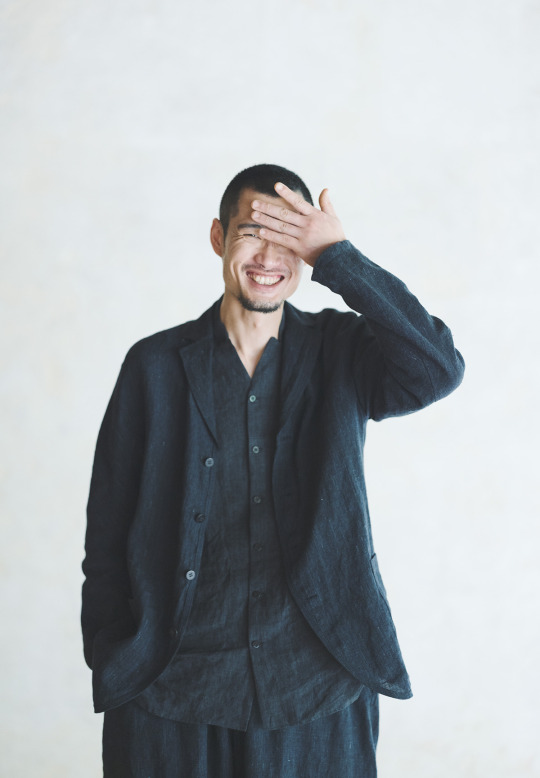
Jurgen Lehl / Babaghuri Men's Wear
Collection
Kiyosumi Main Shop 5/12 - 23 Aoyama 5/12 - 23 Kyoto 5/12 - 23 Sendai 6/9 - 19 Gifu 6/9 - 20 Daimaru Tokyo 6/9 - 20 Takashimaya Shinjuku 6/9 - 20 Daimaru Shinsaibashi 6/9 - 20
31 notes
·
View notes
Photo

”みかんジュースのでる蛇口ですよ”の誘い文句にまんまと踊らされる。#kyoto #daimarukyoto #daimaru #ehime (大丸京都店)
1 note
·
View note
Text

【京都個展まであと9日】
あまりの暑さに火傷しそうな今日この頃、個展までの日数も少なくお尻に火がついてきました…!
さて、新作「アヌビス」のご紹介です。
アヌビスはエジプトの神話に登場する冥界の神のことです。死者の眠りと未来を守り、狼のような犬科の頭部を持つ半獣、もしくは狼そのものの姿をしていると云われています。太陽神ラーの天秤を持って死者の罪を量る役割を持ちます。
本作では中央に黒狼を、背景にはヒエログリフ(古代エジプトの象形文字)でアヌビスという存在を象徴的に描いています。金箔で描いた天秤には、向かって左手に死者の心臓が入った壺を、右手には真理の象徴とされるマアトの羽根を乗せています。
いずれ迎える審判の時までに、羽根より罪の軽い心を持てるのか…悩ましいところです😅
ーーー
「ミチヨ スクラッチ絵画展 〜神話伝承 古今東西〜」
7月17日(水)〜23日(火)※最終日午後5時閉場
京都大丸店 アートサロンESPACE KYOTO
【Only 9 days to go until my solo exhibition in Kyoto!】
It's so hot today that I feel like I'm going to get burned, and my butt is on fire, this japanese idiom means to be a tight corner, with only a few days left until my solo exhibition...!
Now, I would like to introduce my new work "Anubis".
Anubis is the god of the underworld in Egyptian mythology. He protects the sleep and future of the dead and is said to be a half-breed with a canine head like a wolf, or a wolf itself. He holds the balance of Ra, the sun god, and weighs the sins of the dead.
In this work, the black wolf in the center and the hieroglyphs in the background symbolically refer to Anubis. The balance, painted in gold leaf, holds in its left hand a vase containing the heart of the dead, and in its right hand the feather of Maat, the symbol of truth.
It is a question of whether one can have a heart lighter in sin than the feather by the time of the judgment that will eventually come 😅.
———
Michiyo Scratch Painting Exhibition - Mythological &Lore, Everywhen and Everywhere.
Wed 17 - Tue 23 July *Close at 5pm on the last day.
Kyoto Daimaru Art Salon ESPACE KYOTO
#ミチヨ#michiyo#展示会#art#スクラッチ画家#神話#myth#スクラッチ絵画#アート#scratchart#アヌビス#エジプト#ヒエログリフ#egypt#Anubis#hieroglyphs
18 notes
·
View notes
Photo
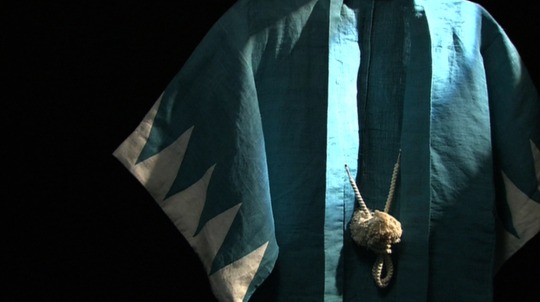

The Shinsengumi’s uniform: asagi blue haori
Part 1
(source: https://shinsengumijapan.com/2020/10/11/haori/)
The Shinsengumi uniform was an iconic light blue color (Asagi-iro) unlined haori. According to the book “History of the Mibu Ronin” (八木為三郎老人壬生史話) by Yagi Saburo when he was elderly, when the team members first arrived at Mibu, everyone was in rags and was obviously impoverished.
Serizawa Kamo referenced the Ako Roshi in the incident of the Forty-seven Ronin in 1701. At that time, the lord of the Ako Clan was framed by Kira Yoshio, and Ako Clan’s boss Ishiuchosuke assembled forty-six ronin to kill Kira in his mansion. They beheaded and killed the enemy. At that time, they were wearing black haori with mountain-shaped patterns embroidered on the cuffs. This was the inspiration of the new Shinsengumi uniform.

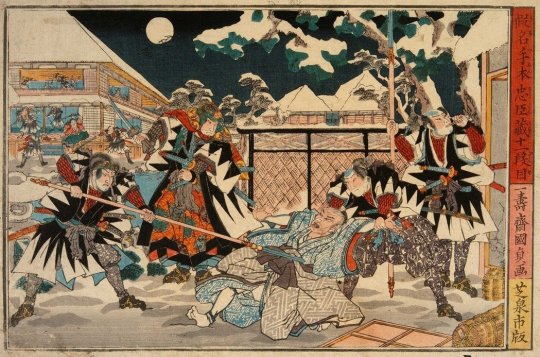
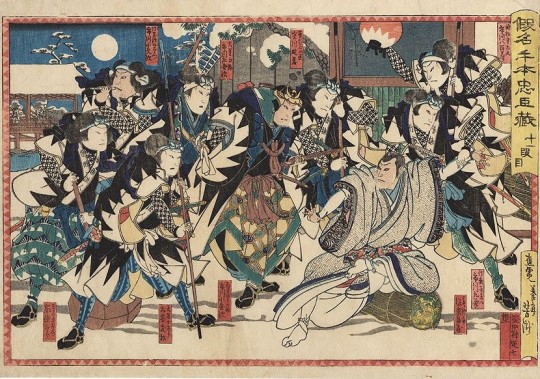
Although this event ended with 47 people being ordered to cut their belly, Oishi Uchizosuke fully demonstrated his loyalty to his lord and his strong faith, which was praised by later generations, and it also brought out the samurai who ignored their own lives in order to maintain their reputation and seek the righteousness of being abandoned. This story was adapted into "The Soul of the 47 Ronin" by Hollywood films in 2013. It is said that Serizawa Kamo was proud of borrowing from the costumes of the Ako clan. Taiga drama "Shinsengumi!" protrayed Kondo Isami as the one interested in Ako's clothing, while Serizawa Kamo’s lover Oume suggested a light blue color to which Serizawa Kamo agreed.

The scene of the Ako Ronin's revenge for their lord is a well-known allusion in Japanese families and one of the three major revenge events in Japanese history. It is often adapted by local or even foreign countries as stage plays, Kabuki, TV series and movies.
As for the asagi color, it is a blue-green color in the traditional Japanese color system, and its name comes from the light-colored green onion leaves. Slicing abdomen is the most noble way of death for samurai, and light blue was the traditional dress color worn by samurai when cutting abdomen. It is said that the light blue color adopted by the Shinsengumi is to remind the team members to swear to death and fight to the death for the most dignified moment.
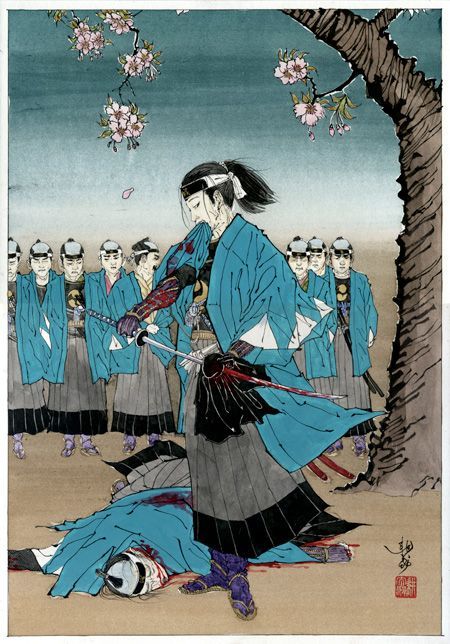
An ancient [modern] painter's depiction of Shinsengumi wearing team uniforms
Part 2
(source: https://shinsengumijapan.com/2020/10/17/asagi-iro/)
In historical records, the haori of Shinsengumi is light blue, but the previous dyes are ultimately different from modern chemical toning. According to Nagakura Shinpachi’s memoirs, the team uniforms of Shinsengumi were arranged by the Daimaru store (Dai-Monjiya) at that time. Daimaru (now Daimaru Matsuzakiya Department Store ) was founded in Fushimi, Kyoto in 1717. In view of this, the Daimaru Kyoto store now reproduces the light blue haori of the Shinsengumi based on the natural dye technology and hand-woven linen materials recorded in the history of the Edo period. Compared with the color of haori produced in general TV and movie productions, the asagi color is slightly darker.
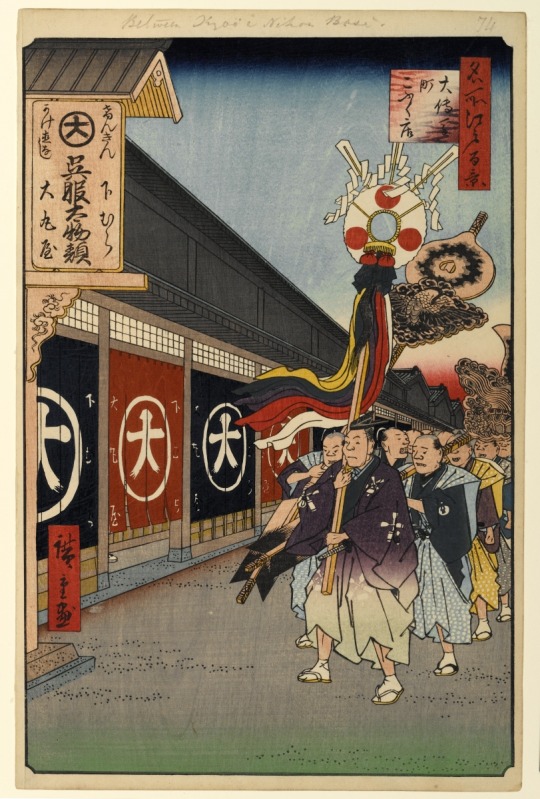
Daimaru Clothes Shop
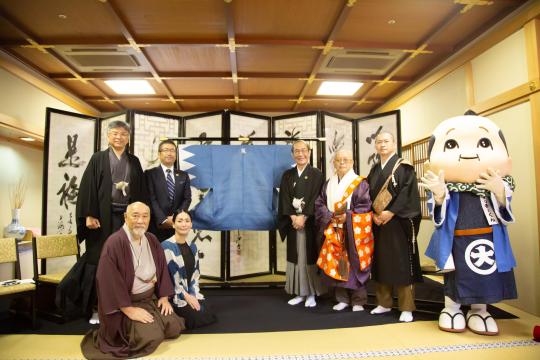

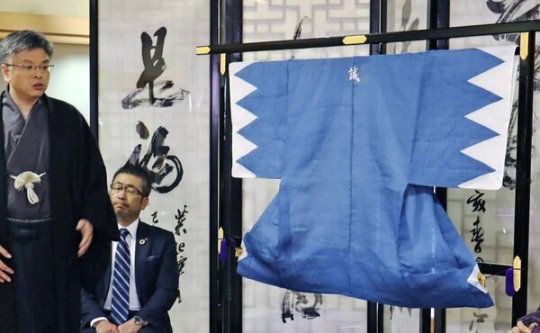
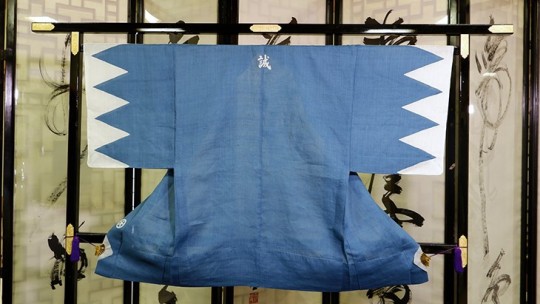
The reproduction of the Shinsengumi haori was exhibited at Mibu Temple in April 2020
In film and television, we always see the Shinsengumi arranged in formation, wearing team uniforms to attend work, very prestigious. But according to Yagi Yusaburo's "Shinsengumi Legacy", the team members were not satisfied with the uniform. I believe that in view of the financial constraints at the time, the team uniforms of the Shinsengumi were made of coarse hemp. It made the upper body too hot and it looked particularly shabby. What's more, in the early Edo period, the light blue color has become a symbol of the lower-ranking samurai outside the city. It is said that when the samurai came to Edo from outside the city, they all chose to wear asagi blue kimono, a color that was a smash hit at the time as in order to blend into this prosperous area. Little did they know, the people in Edo usually use this beautiful color of silk as a the inner part of their kimono, so it’s not exposed to others, so it’s understandable that the Shinsengumi members were somewhat against it. During street patrols, only one or two people at the front put on team uniforms. After the Ikedaya incident, this light-blue set of haori was gradually forgotten, and it can be said that it has only been worn for a year. This is absolutely contrary to the public's perception of the Shinsengumi image.
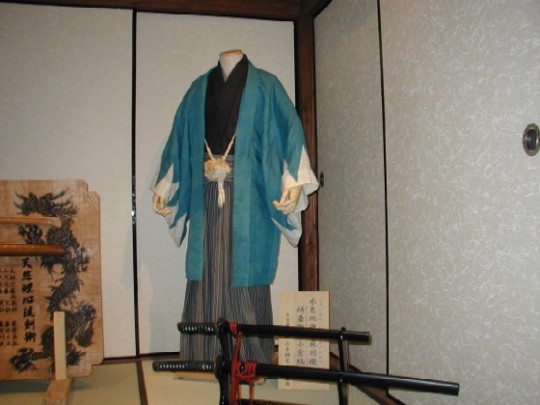
Haori display
This haori was not very popular among the members, but the "sincere" flag has become a favorite of everyone. Yagi Yusaburo recalled that the team members particularly liked to wave the flags one after another in the open space in front of the Maekawa House. They even made lanterns with the character "sincerity" and mountain-shaped patterns, which were used for stationing and attending work at night. The team members who lived the life of a ronin are now settled down. For them, the identity of Shinsengumi allows them to find a sense of identity in their hearts, and the word "sincerity" makes them dignified as a samurai. The three reasons for choosing the word "sincerity" are less important than this symbolic meaning.
77 notes
·
View notes
Photo

Marunouchi and Tokyo Station
The red-brick fronted building of the beautifully restored Tokyo Marunouchi Station is one of the most impressive pieces of architecture in the city, setting itself apart from the surrounding skyscrapers made of glass and steel. In it you will find one of the most important mass transportation hubs in the city, connecting the country with bullet trains that run from Hakodate in the far north to Fukuoka in the southwest. Not only does the station offer a plethora of dining and shopping options, but it is surrounded by some of the most beautiful sights in the city, from the Marunouchi business district to Nihonbashi, downtown Edo, old Tokyo.
Getting off the train, heading towards the west exit of Marunouchi, we find ourselves a step away from the Imperial Palace. Or walking out the gate to the east of Yaesu, we’ll be a few minutes walk from shopping districts like Ginza or Nihonbashi.
The central station through which every traveler passes
It is not an exaggeration to say that probably every traveler in Japan passes through Tokyo Station at some point. It is the busiest train station by number of trains in Japan, and connects the country along its entire length via the bullet train network, with regular departures to other major cities such as Kyoto. It also offers quick and easy access to Narita and Haneda airports, and is only 15 minutes from Japan’s busiest station, Shinjuku.
Train lines that arrive at Tokyo Station
As a transit hub, Tokyo is one of the most connected stations in the city. It is one of the most important terminals of the JR Yamanote line, which runs through the center of Tokyo and passes through several of the busiest and most interesting neighborhoods in the city. It also passes the Marunouchi line, which gives direct access to Ginza, Shinjuku and Ikebukuro. For those who plan to leave the city, just hop on a bullet train, better known as shinkansen, and you can reach the large northern island called Hokkaido or the southern island called Kyushu. Tokyo Station is a gateway to the city and the rest of Japan.
Bus
Leaving Tokyo Station on the Yaesu side, you will meet buses that will take you to the main cities of the country, as well as to Tokyo’s two main airports.
On the way to Narita, lines such as the Airport Limousine and the TYO-NRT leave several times an hour, with reduced schedules during the early morning hours or very late at night. The trip is approximately one hour and twenty minutes.
On the way to Haneda, lines such as the Airport Limousine or the Keihin Kyuko Bus leave several times an hour, with reduced schedules early in the morning or late at night. The trip takes between 30 to 55 minutes, depending on the service and the destination terminal.
The service is usually more expensive during non-regular hours, and you can make reservations online or buy tickets at the time of travel.
A maze of shopping streets
Tokyo Station is truly a place to shop ’til you drop, and you don’t need to walk far to get back to your train! The station is full of shops, both inside the travel area and outside. They can take a look at GRANSTA, full of delights to the palate, souvenirs and fashion products; explore First Avenue Tokyo Station, home to the famous Tokyo Character Street (for the many shops you’ll find featuring famous characters); take a walk through Yaesu Chikagai, an underground shopping center with more than 180 businesses; or go up to see the Daimaru Tokyo department store, one of the largest in the downtown area of Tokyo.
If that’s not enough, and you need a quick concentrated shopping spree, you can visit the Marunouchi Building, Shin Marunouchi, KITTE or Marunouchi Brick Square, all surrounding Tokyo Station.
Yaesu Chikagai, the underground shopping center of Tokyo Station
Yaesu Chikagai is one of the largest underground shopping centers in Japan with more than 180 businesses, 60 of which are restaurants and cafes that will recharge you with energy to continue your purchases! When it comes to fashion, you can find everything from casual attire, sporting goods and custom shoes. You can also find household goods stores, pharmacies and unique souvenirs from Japan.
Continue Reading >>>
2 notes
·
View notes
Photo
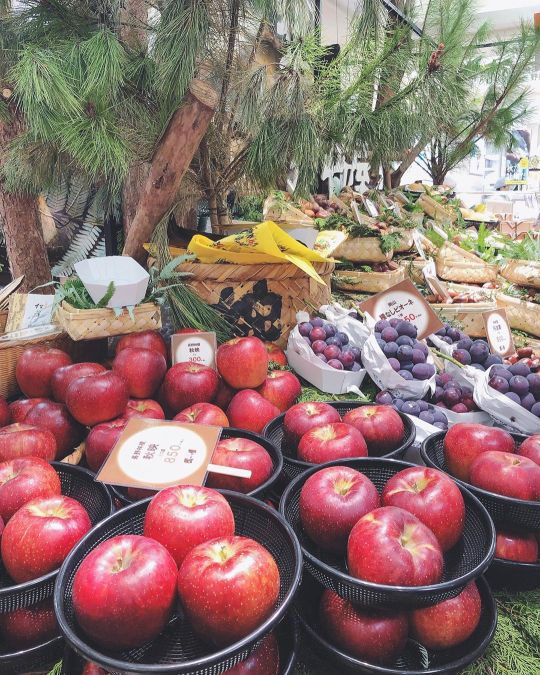
🍎🍇 . . . . . #fruit #daimaru #kyoto #japan #japanfoodie #visitjapan #discoverjapan #explorejapan #japantrip #japantravel #japanculture #visitjpn #amazingjapan #japanawaits #instajapan #ilovejapan #travel #holiday #foodstagram #foodpics #instafood #foodpornshare #foodadventure #foodshare #foodphotography #sydneyfoodie #feedfeed #sydneylocal #instaeats #japanexperience (at Kyoto, Japan) https://www.instagram.com/p/B5NDO-LBRyW/?igshid=nzk4m2zp28gg
#fruit#daimaru#kyoto#japan#japanfoodie#visitjapan#discoverjapan#explorejapan#japantrip#japantravel#japanculture#visitjpn#amazingjapan#japanawaits#instajapan#ilovejapan#travel#holiday#foodstagram#foodpics#instafood#foodpornshare#foodadventure#foodshare#foodphotography#sydneyfoodie#feedfeed#sydneylocal#instaeats#japanexperience
0 notes
Photo

2016.11.10 Daimaru - Kyoto
1 note
·
View note